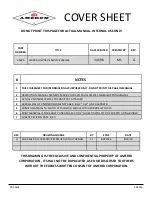
PN 05606
04/2020
INSPECTING THE EXTINGUISHER
This extinguisher must be inspected at regular intervals (monthly or more often if circumstances
dictate) to insure that it is ready for use. Inspection is a "quick check" that a fire extinguisher is
available and is in operating condition. It is intended to give reasonable assurance that the fire
extinguisher is fully charged. This is done by verifying that it is in its designated place, that it has not
been actuated or tampered with, and that there is no obvious physical damage or condition to prevent
its operation.
PERIODIC INSPECTION PROCEDURES
(Monthly or more often if circumstances dictate)
NFPA 10 Periodic inspection of fire extinguishers shall include a check of at least the following items:
1.
Located in designated place.
2.
No obstruction to access or visibility.
3.
Pressure gauge reading or indicator in the operable range or position.
4.
Operating instructions on nameplate and facing outward.
5.
Tamper seal not broken or missing.
6.
Examination for obvious physical damage, corrosion, leakage, or clogged nozzle.
7.
Determine fullness by weighing.
8.
Hose properly coiled and shut
-
off nozzle in its mount.
9.
Wheels rotate freely.
MAINTENANCE
NFPA 10 Maintenance is a "thorough check" of the extinguisher. It is intended to give maximum
assurance that a fire extinguisher will operate effectively and safely. It includes a thorough
examination for physical damage or condition to prevent its operation and any necessary repair or
replacement. It will normally reveal if hydrostatic testing or internal maintenance is required.
MAINTENANCE PROCEDURE
1. Clean extinguisher to remove dirt, grease, or foreign material. Check to make sure that the instruction
pictogram is securely fastened and legible. Inspect the cylinder for corrosion, abrasion, dents, or weld
damage. If any damage is found and you doubt the integrity of the cylinder, hydrostatically test to factory
test pressure, using the proof
-
pressure method, in accordance with instructions in CGA pamphlet C
-
1 and
C
-
6 and NFPA 10. See proper method of depressurizing and reclaiming Halon 1211 in Complete
Maintenance procedures.
NOTE:
WHEN CLEANING, AVOID USE OF SOLVENTS AROUND THE PRESSURE GAUGE.
THEY COULD SERIOUSLY DAMAGE THE PLASTIC GAUGE FACE.
2.
Inspect the extinguisher for damaged, missing, or substitute parts. Only factory replacement parts are
approved for use on Amerex fire extinguishers.
3.
Weigh the extinguisher, and compare with weight printed in the "Weight Block" section on the nameplate
(label). Recharge extinguisher if weight is not within indicated allowable tolerances.
4.
Check the date of manufacture printed on the extinguisher label (nameplate) or on the agent cylinder
dome. The agent cylinder must be hydrostatically (proof
-
pressure) tested every 12 years to the test
pressure indicated on the nameplate (will vary according to size). Model 695, 50 lb. (480 psi); Model 600,
150 lb. (500 psi). Discharge hoses must also be hydrostatically tested (proof pressure) every 12 years to
300 psi, or service pressure, whichever is higher.
5. Visually inspect the pressure gauge:
a. If bent, damaged, or improper gauge, depressurize and replace.
b. If pressure is low, check for leaks.
c. If over pressurized (overcharged), depressurize the extinguisher and follow recharge instructions.


























